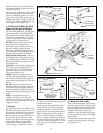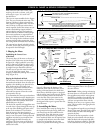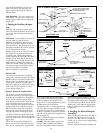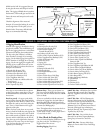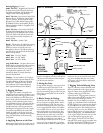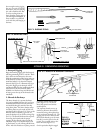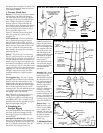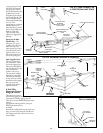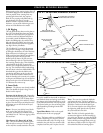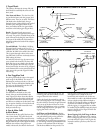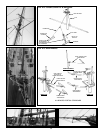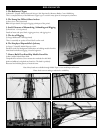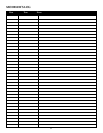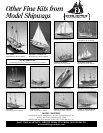
18
3. Topsail Yards
The jackstays, footropes & stirrups, lifts and
brace blocks are essentially the same as for the
lo
wer yards.
Clew Lines and S
heets
-
The clew lines (29)
are just like the lower yard clew garnets, just a
different name. There are no tacks. The sheets
(28) hook to the clewline block, then go
through a sheave (a hole will do) at the ends of
the lower yards, through the block on the
lower yard inboard of the clew garnet block
and down to the belaying pins (Figure H-6).
Parrels - The topsail yards move up and
down. To hold the yard against the mast a par-
rel is used. The parrel is a beaded fixture so the
yards will move freely along the mast. Howev-
er, because of the small scale of this model, a
simple line without the beads will be adequate
(Figure H-7).
Tye and Halliards - The halliard ( for lifting
the topsail yards) is made up of a tye (37)
attached to the yard, a runner (38), and finally
a fall (also 38) which is the tackle at the deck.
The tye passes through a sheave in the mast.
Just drill a hole if you have not already done so
while making the masts.
For both fore and main rigs, the runner seizes
to an eyebolt in the channels. The lower fall
block also seizes to an eyebolt in the channels
but on the opposite side of the ship. One dif-
ference between fore & main, the rig is flipped
so the foremast fall is on the starboard side and
main mast on the port side. Figure H-8 illus-
trates the rig.
4. Fore Topgallant Yard
Everything is basically the same as the topsail
yards except for the halliard. The runner is
eliminated so you have only the tye (39) and
fall (40). The lower fall block is hooked at the
fore top, or at the channel but the line still
goes to the deck for belaying.
5. Rigging the Yard Braces
You should have the blocks on the yards
already. Now you need lead blocks at the
masts. Figure H-9 shows where these blocks
are located. All brace lines belay at deck level.
Note that the sketch shows the main topsail
yard lifts set to eyebolts on the fore lower mast
cap. An option would be to fix the blocks and
fixed ends to a rope collar around the mast
head just under the cap.
6. Fore & Main Gaffs
& Main Boom
The foresail on the fore gaff of the lower fore-
mast is loose footed. The gaff is fitted with
vangs (port & starboard) that extend from the
peak of the gaff to the outboard deck to steady
the gaff when the sail is furled. P
eak and thr
oat
halliar
ds raise and lo
w
er the gaff. For our
model, without sails, the sheet for the for
esail
would have been removed with the sail. The
remaining peak and throat halliards and the
vangs are identical to the mainsail.
Unlike the foresail, the mainsail has a boom
and a boom topping lift (44). N
ormally
, when
the sail is furled or r
emo
v
ed, the gaff is lo
wered
to lay on top of the boom. However, for the
model the gaff looks better in the up position
and the v
angs help fill in the open space.
The
rigging plan shows it this way.
Gaff Throat and Peak Halliards - Rig the
throat (42) and peak (4) halliard lower blocks
and peak halliard seizing on the gaff before
installing the gaff. The upper blocks are
secured below the top and mast cap respective-
ly. The hauling end of the peak halliard should
go down on the starboard side of the boom
and the throat halliard on the port side. The
belaying plan is confusing because it indicates
what appears to be eyebolts in the deck
between the main mast fife rails. In this case,
there would be a tackle in the halliards hooked
to these eyebolts and the fall lines belayed to
the fife rail. The fore fife rail has no indication
at all where the halliards are belayed. To sim-
plify the rigging, it is suggested that no tackles
be installed and the halliards simply be belayed
to pins in the fife rail. See Figure H-10 for the
halliard arrangement.
B
oom
Topping Lifts, Gaff Vangs, & Boom
Sheet
- Figure H-11 illustrates these running
lines. The topping lifts (44) are a pair of lines
por
t and starboar
d. Quite a hefty rig but the
mainsail would be quite heavy when the sail
is furled.
FIG. H-3 LOWER YARD CLEW GARNETS, SHEETS & TACKS
FIG. H-4 LOWER YARD SLING & STRUSS
CLEW GARNET
P/S
HOOK
TOGETHER
T
ACK P/S
SHEET P/S
BELA
YTO
CAVIL
EYEBOL
T
HOLE (SHEA
VE)
TACK P/S
BOOMKIN
BUL
WARK
(A
T FORE YARD)
BUL
WARK
(A
T MAIN YARD)
BUL
WARK
(A
T MAIN YARD)
SLING
TRUSS
CLEATS ON
FOR
WARD SIDE OF YARD
EYEBOLT AT
DECK P/S
BELA
YTO
PIN RAIL
AT BOW
CL



